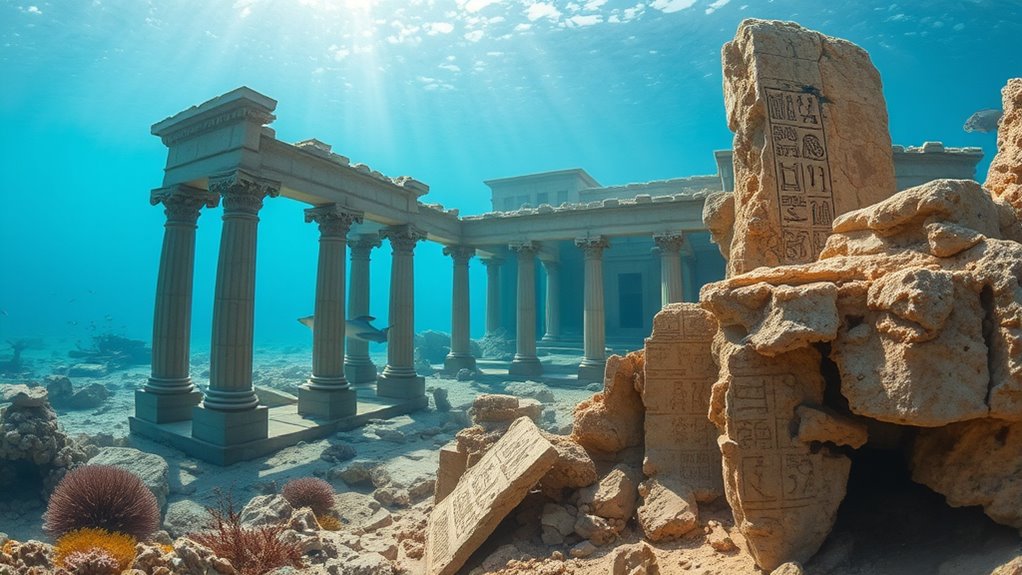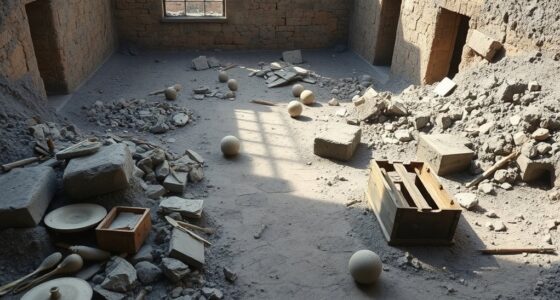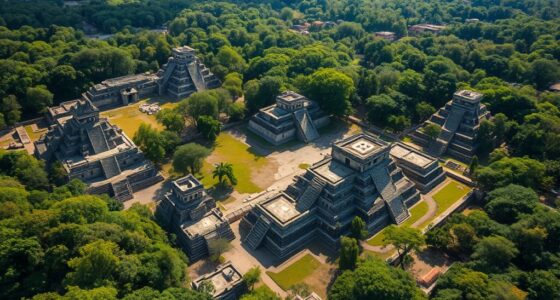Beneath Alexandria’s harbor, the sunken palace of Cleopatra hides an ancient world waiting to be explored. Marine archaeology uncovers remnants like stone foundations, columns, and mosaics that reveal the city’s grandeur and engineering mastery. These underwater structures demonstrate how ancient builders crafted enduring monuments, with advanced technology now helping uncover their secrets. If you want to learn more about this fascinating submerged site and what lies beneath the surface, there’s much more to discover.
Key Takeaways
- The sunken palace of Cleopatra is believed to lie beneath Alexandria’s harbor, submerged due to earthquakes and rising sea levels.
- Marine archaeology employs sonar, ROVs, and diving to locate and study the submerged ruins.
- The site reveals ancient engineering marvels, including foundations, columns, and mosaics preserved underwater.
- Challenges include environmental conditions and delicate structures, requiring advanced technology for careful excavation.
- Ongoing discoveries continue to uncover new insights into Cleopatra’s grandeur and Alexandria’s ancient history.

Have you ever wondered what secrets lie beneath the waters of Alexandria? Beneath the shimmering surface, there’s a world waiting to be uncovered—an ancient city lost to time, shrouded in mystery and history. The sunken palace of Cleopatra isn’t just a legend; it’s a tantalizing puzzle for marine archaeology enthusiasts and historians alike. As you immerse yourself in this submerged landscape, you realize that exploring such a site requires more than just curiosity. It demands an understanding of ancient engineering and a mastery of underwater exploration techniques.
Marine archaeology plays an essential role here, helping uncover the remnants of Cleopatra’s grandeur while preserving the integrity of the site. Underwater archaeologists use sophisticated tools—sonar imaging, remote-operated vehicles, and diving technology—to map and examine the ruins. These investigations reveal stone foundations, columns, and intricate mosaics that hint at the splendor of the once-magnificent palace. Every fragment tells a story of a civilization that mastered engineering feats to build structures that could withstand the test of time and the relentless push of the sea. It’s awe-inspiring to realize how ancient engineers designed these structures with such precision, knowing they’d be vulnerable to the ocean’s power, yet still managing to create lasting monuments.
Marine archaeologists uncover Cleopatra’s palace using sonar, ROVs, and diving tech—revealing ancient foundations and mosaics that tell a story of engineering mastery.
The process of uncovering this lost city is meticulous. You learn that marine archaeologists painstakingly document every find, piece by piece, to reconstruct how the palace might have looked in its prime. The challenge isn’t only in locating the site but also in ensuring that the delicate structures aren’t damaged during excavation. This requires a delicate balance of advanced technology and expert craftsmanship, all driven by a desire to honor history while respecting the ocean’s natural habitat. The more you explore the details, the clearer it becomes that this isn’t just about discovering ancient stones. It’s about bridging the gap between past and present, understanding how ancient engineering enabled such marvels to endure beneath the waves for centuries. Additionally, underwater exploration techniques play a crucial role in safely investigating these submerged sites.
As you stand on the edge of this submerged world, you’re struck by the sense of connection. Cleopatra’s palace isn’t just a relic; it’s a testament to human ingenuity and the enduring power of history. The ongoing efforts of marine archaeologists continue to peel back layers of sediment and time, revealing secrets that could reshape our understanding of ancient Alexandria. So, beneath the waters of this historic harbor, lies not just a sunken city, but a timeless story waiting to be told—one that combines the marvels of ancient engineering with the relentless pursuit of discovery.
Frequently Asked Questions
Has the Sunken Palace Been Officially Explored or Excavated?
You might wonder if the sunken palace has been officially explored or excavated. While many underwater mysteries fuel mythical legends, efforts to investigate the site remain limited. Some underwater explorations have occurred, but definitive excavations haven’t confirmed the palace’s location or details. The intrigue continues, as researchers and divers are keen to uncover what secrets lie beneath Alexandria’s harbor, keeping the myth alive and fueling ongoing fascination with these underwater mysteries.
What Artifacts Have Been Recovered From the Palace Site?
You’ll find that many artifacts have been recovered from the palace site, including stunning ancient jewelry and maritime tools. Remarkably, over 500 relics have been uncovered, shedding light on the opulence and daily life of Cleopatra’s era. These artifacts help researchers understand the history of Alexandria’s harbor, revealing insights into trade, craftsmanship, and maritime activities that once thrived there.
How Deep Is the Palace Beneath Alexandria’S Harbor?
You might wonder how deep the ancient construction lies beneath Alexandria’s harbor. While exact measurements are uncertain, mythical legends suggest it rests several meters below the surface, hidden from view. Modern technology helps explore these depths, revealing the possible remains of Cleopatra’s palace. Though the precise depth remains debated, ongoing discoveries continue to uncover secrets buried beneath the water, blending history and myth in this fascinating underwater site.
Are There Ongoing Efforts to Preserve the Ruins?
Like guardians of a hidden treasure, marine archaeologists actively work to preserve the ruins beneath Alexandria’s harbor. Yes, ongoing efforts focus on conservation challenges, employing advanced technology to study and protect these submerged structures. They aim to balance exploration with preservation, ensuring history isn’t lost to time or decay. Your curiosity drives these initiatives, helping safeguard this underwater legacy for future generations to appreciate and learn from.
Could the Sunken Palace Be Linked to Other Submerged Structures?
You might wonder if the sunken palace connects to other submerged structures. It’s possible, as ancient maritime connections often linked cities through submerged city networks. These underwater sites could reveal a broader picture of Alexandria’s maritime history, showing how different parts of the city and its surrounding areas were interconnected. Exploring these links can help you understand the extent of ancient maritime trade routes and the complex underwater landscape beneath Alexandria’s harbor.
Conclusion
As you consider the possibility that Cleopatra’s sunken palace still rests beneath Alexandria’s harbor, it’s tempting to believe in hidden treasures and ancient secrets. While some believe recent discoveries hint at its location, concrete proof remains elusive. Yet, the idea sparks your imagination—what stories, artifacts, or mysteries lie beneath the waves? Maybe one day, new technology will finally reveal the truth, bringing history’s secrets to light and transforming what you thought you knew about Cleopatra’s lost world.









